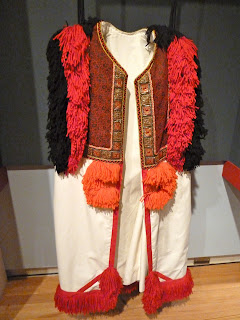 |
| Corpus Christi dancers in Ecuador wear ornate headdresses like this one. |
Why do people create? Think about it and make a list. I’ve been thinking about this question for a long time, and some of the reasons I have come up with are these:
· To communicate and share ideas with others
· To provide others with visual experiences
· To make a record of what is happening
· To celebrate events
· To adorn bodies (clothing, jewelry, etc.)
· To do something that has not been done
· To express cultural traditions
· To make a record of a person or object
· To add beauty to the world
People from all cultures create and leave a record behind that highlights features of their cultures. And these people, no matter how different from each other, have much in common.
Think about the clothes you are wearing right now. Did you design and make them yourself? If not, who designed and made them? What made you choose these clothes? Are your clothes in the same style as clothes your grandparents wore at your age? If not, how are they different? What will the clothes you are wearing today tell kids one hundred years from now about life in the early 21st century? What other cultural artifacts from your life will tell future generations about your culture?
In Santa Fe, there a place called the Museum of International Folk Art. Folk art from around the world is on display and it is fascinating to view how individuals around the world have left behind interesting artifacts they created for many reasons. Do you know what folk art is? It is art created by everyday people who are not trained artists. They use whatever materials are readily available to them. Often, these artisans create functional items that are also beautiful. Look carefully at each photo below. What does it tell about the artist? What does it say about the artist’s culture?
 |
| Portable boxes from Peru were created to illustrate local scenes. What can you learn about Peru by studying this box? |
 |
| These flasks were used by horsemen in the 1800s to carry water. What do we use today to carry water? If you could have one of these flasks, which one would you choose? |
 |
| Would you like to wear this necklace? Why or why not? |
 |
| Many cultures create pottery, functional items generally used for holding or serving food. This majolica pottery was made in Peru and features green designs on a white background. |
 |
| What purpose do you think this fellow served? He is a house blessing ornament and would have been placed on the roof of a house in Andean countries. |
 |
| People all over the world from a multitude of cultures create and wear hats. What kind of hats do you wear? Look how the folk artist decorated this hat. What materials were used? |
 |
| This colorful costume was used in Bolivia to celebrate the Easter season. Many places in the world have similar celebrations. Mardi Gras and Carnival are two you may know about. |
 |
| This is another headdress worn by Corpus Cristi dancers in Ecuador. Try to imagine dancing while wearing this tall piece on your head. |
 |
| This wedding coat was on display and available for trying on. It weighs 21 pounds! When I put it on, my shoulders sagged from the weight, but I felt very festive. |
 |
| What are the features of this wedding outfit? It may seem very different to us, but our wedding dresses would seem strange to the Macedonians. |
 |
| This amazing tapestry must have taken months and months (or years) to create. Each animal was created using a variety of stitches. |






No comments:
Post a Comment